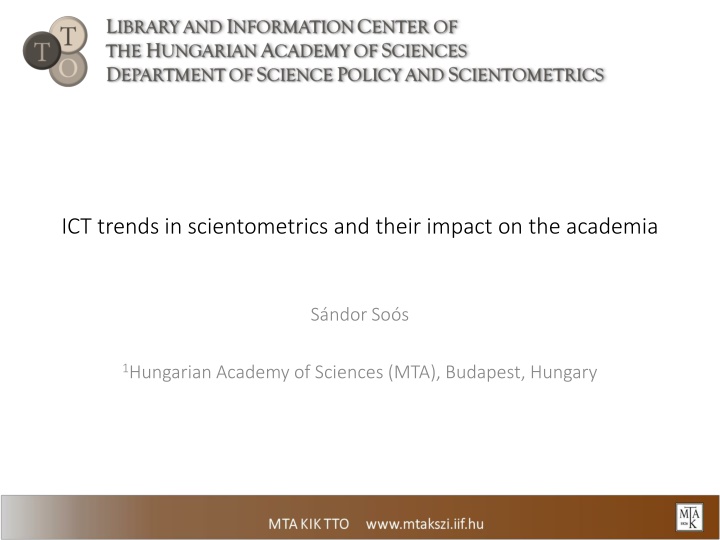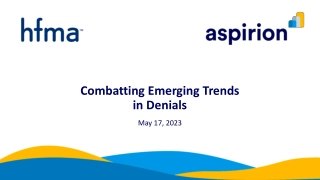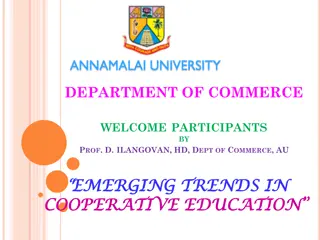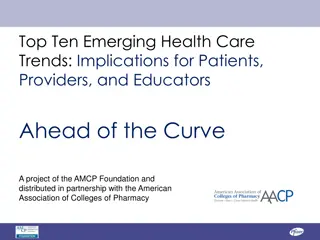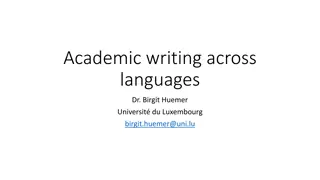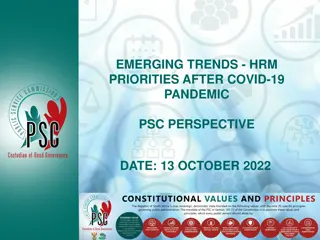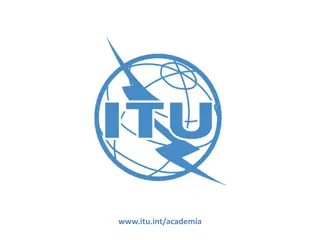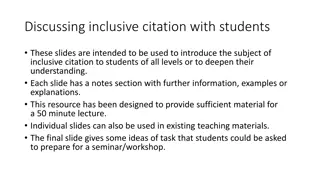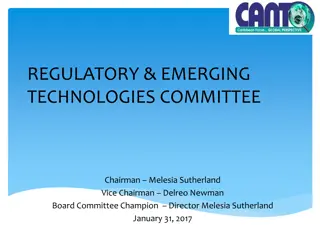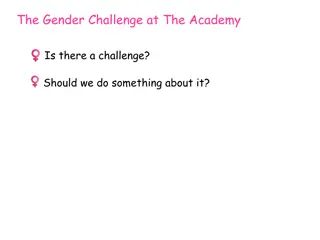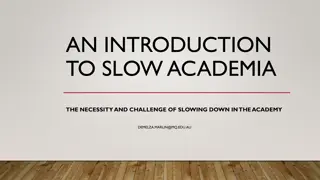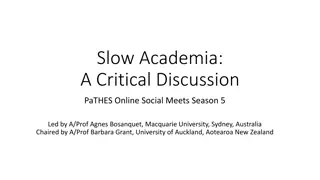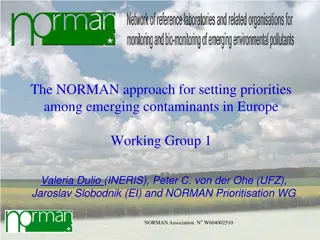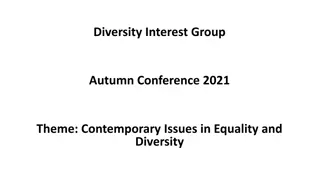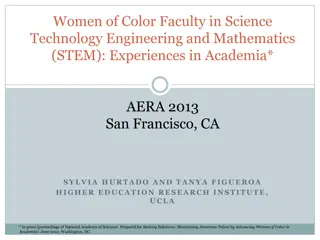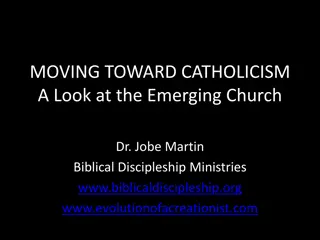Emerging Trends in Scientometrics and Academia Impact
Scientometrics, a field studying scientific communication quantitatively, has seen evolution in methodologies and research directions. The emergence of citizen bibliometrics and the utilization of big data have influenced research evaluation practices. Explore the impact of ICT trends on academia and the evolving landscape of scientometrics in this insightful content.
Download Presentation

Please find below an Image/Link to download the presentation.
The content on the website is provided AS IS for your information and personal use only. It may not be sold, licensed, or shared on other websites without obtaining consent from the author.If you encounter any issues during the download, it is possible that the publisher has removed the file from their server.
You are allowed to download the files provided on this website for personal or commercial use, subject to the condition that they are used lawfully. All files are the property of their respective owners.
The content on the website is provided AS IS for your information and personal use only. It may not be sold, licensed, or shared on other websites without obtaining consent from the author.
E N D
Presentation Transcript
ICT trends in scientometrics and their impact on the academia S ndor So s 1Hungarian Academy of Sciences (MTA), Budapest, Hungary
Scientometrics as a research field By definition: The quantitative study of scientific communication Bj rneborg & Ingewersen, 2004
Methodological frameworks in Scientometrics ( ) Information science Network science Computer science Sciento- metrics Economics Econo- Metrics Statistics
Research directions in Scientometrics Field Scientometrics Direction Structural Evaluative Dynamics, development, structure of S&T (cognitive, social level) Models and measurement of research performance Research program
First wave: two levels of bibliometrics Science Citation Index (SCI) 1961, Institute of Scientific Information, Eugene Garfield Journal Citation Report (SCI) SCI-derivative, 1975, Impact Factor (IF), 1955 Eugene Garfield Web of Science (WoS) On-line platform for SCI (+JCR), 2001 Early stage: study of the development and direction of scientific research, rather than to evaluate its quality (Wouters et al. HEFCE, 2015) > Professional bibliometrics bibliometrics Professional Nevertheless, the SCI s success did not stem from its primary function as a search engine, but from its use as an instrument instrument for for measuring scientific productivity possible by the advent of its by-product, the SCI Journal Citation Reports (JCR) and its Impact Factor rankings. (Garfield, 2010) > Citizen measuring scientific productivity, made Citizen bibliometrics bibliometrics
Emergence of citizen bibliometrics Recognition of the potential in research evaluation (Policy): 1980 s, 1990 s Big data availability Quick utilization in research administration BUT BUT Lack of an underlying theory of performance (impact): And with the creation of the Science Citation Index, the field of bibliometrics and the use of citation analysis in research evaluation have been driven availability of data to the point that it has come to shape the definition of scientific impact. (Haustein, 2016) have been drivenby the Policy pull + Data push
First wave: theory-unladenness Performance dimension Theoretical level Indicators (measurement) Sociology of science: Scientific impact # citations, IF, Theory of citation
Characterization of citizen bibliometrics Citizen bibliometrics : bibliometrics-based evaluation activity carried out by non- experts (mostly in science administration) Category mistakes (JIF misuse in author (individual) evaluations, aggregate IF ) Blind application (context and problem-insensitive) Comparing apples with oranges (raw, unnormalized, size-dependent etc. Indicators) Single-number obsession (Hirsch-index) Metric-based evaluation absolutized Wave 2 further characteristics Selective on access (commercialized indicators vs. Open access indicators) Conservative (IF, Hirsch, raw cit count obsession ) Self-service Theoretically non-grounded or not sound Decontextualized (mechanistic application of metrics, not fitted to the assessment problem)
First wave effect: responses within academia Pressure and strategic behavior in response to the IF and Hirsch culture Goal displacement Task reduction Salami publishing Strategic collaborations (to boost individual metrics) : farm citations Gaming Hiring of researchers Declarations: DORA , The San Francisco Declaration on Research Assessment (DORA), initiated at the 2012 Annual Meeting of the American Society for Cell Biology by a group of editors and publishers of scholarly journals, recognizes the need to improve the ways in which the outputs of scientific research are evaluated.
Meanwhile in professional bibliometrics Performance dimension Theoretical level Indicators (measurement) Sociology of science: theory of citation # citations, IF, Scientific impact Normalized, model- based impact metrics Statistical models of the citation process
Meanwhile in professional bibliometrics Scientific Scientific impact Statistical characterization of citation distributions Models of citation dynamics Main factors of citedness (for papers): fields, doctypes, age Normalization for factors Normalized indicators (MNCS, PP10% etc.) Output and Output and productivity productivity Size dependencies Activity indexes Collaboration Collaboration Co-authorship indicators Quality Quality Journal metrics (SJR, SNIP, Eigenfactor, AIS etc.) Profile Profile Interdisciplinarity metrics (IDR) impact Dimensions of performance and Commensurability
Second wave: Metrics services 2004: Scopus (Elsevier) and Google Scholar (Google) Related on-line metrics services (open access) Publish Publish or or Perish Hirsch index and derivatives (e-index, g-index, Hl-index etc.) Correcting the Hirsch index for various known biases Perish (Anne Harzing) on Google Scholar data Scimago Scimago Journal and Country Journal and Country Rank SJR metric and its Quartile-based presentation new quality dimension and more sound cross-field comparisons Rank (Scimago Group, Uni Granada, Spain) Initial infiltrations of professional bibliometrics
Second wave: Professional metrics services ISI Thomson Reurters: InCites research analytics tool (WoS-based) Elsevier SciVal research analytics tool (Scopus-based) On-line metrics services Subscription-based Commertionalization of professional bibliometrics
Second wave: Professional metrics services Scival: Map of research competences Science mapping -> Strategic research intelligence
Wave2 outcome: citizen bibliometrics 2.0 Citizen bibliometrics : bibliometrics-based evaluation activity carried out by non-experts (mostly in science administration) Wave Wave 2 2 potential potential unexpected Selective on access (commercialized indicators vs. Open access indicators) Diversity not accomodated: selective on usage Conservative (IF, Hirsch, raw cit count obsession ) Self-service (commensurability violated) Theoretically non-grounded or not sound Decontextualized due to misinterpreted professionalism (mechanistic application of metrics, not fitted to the assessment problem) Category mistakes (JIF misuse in author (individual) evaluations, aggregate IF ) Blind application (context and problem-insensitive) Comparing apples with oranges (raw, unnormalized, size-dependent etc. Indicators) Single-number obsession (Hirsch-index) Metric-based evaluation absolutized unexpected outcomes outcomes ( (professional professional tools tools unleashed unleashed ) )
Wave2 outcome: responses within academia Pressure and strategic behavior in response to the metrics culture Goal displacement Task reduction Salami publishing Strategic collaborations (to boost individual metrics) : farm citations Gaming Hiring of researchers Confusion concerning publication strategies (SJR or IF Q1?) Trust issues: transparency and communicability reduced
Wave2: ALTmetrics Altmetrics Altmetrics: : response Predecessor: Webometrics (usage and on-line referencing of scholarly content on the Web as alternative impact measuement) Focus of Altmetrics: on-line social acts related to scholarly content on the web as impact indication (detected posts, blogs, reads etc.) response to to the the challenges challenges of of classical classical bibliomerics bibliomerics Priem Priem et Main hypothesized benefits: Much broader range and more dimensions of impact (social impact!) No delay in impact manifestation (citations need years to accrue ) Big data Much wider coverage than citation databases: a fair business for SSH fields as well et al al. 2010: ALTMETRICS . 2010: ALTMETRICS manifesto manifesto
ALTmetrics: Metrics services Big data and technology opportunities
ALTmetrics vs. professional bibliometrics Performance dimension Theoretical level Indicators (measurement) Haustein, S. (2016). Grand challenges in altmetrics: heterogeneity, data quality and dependencies. Scientometrics, 108(1), 413-423. Sociology of science: theory of usage Access, appraise, apply counts Scientific impact Normalized, model- based impact metrics Statistical models of usage Plus: data quality (e.g. persistence)
ALTmetrics: social impact (Scientometrics 2.0) Policy push: the measurement of social impact Is ALTmetrics the answer? Wouters et al., HEFCE, 2015
Summing up: history repeating Policy push Data supply (ISI, WoS) Citizen bibliometrics Strategic behavior First wave Professional bibliometrics Data and ICT supply (Scopus, GS, WoS, tools, services, ALTmetrics) Citizen bibliometrics Strategic behavior Second wave
Way out: good (collaborative) practices Hicks, D., Wouters, P., Waltman, L., De Rijcke, S., & Rafols, I. (2015). The Leiden Manifesto for research metrics. Nature, 520(7548), 429.
